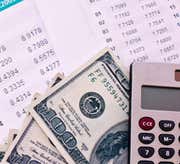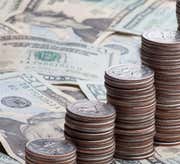|

|
Inflation and interest rates are often mentioned in the same breath, and this is because the two are closely related. In the United States, baseline interest rates are set by the central bank, the Federal Reserve Bank also known as the Fed. The Fed meets eight times a year to set short-term interest rate targets. During these meetings, the CPI and PPIs are significant factors in the Fed's decision, because the Fed, as well as other major central banks, have a specific interest rate target in mind for the economy to achieve, usually 2-3% annually. This is known as inflation targeting. If inflation is the cost of saving money, interest rates are the cost of borrowing it.
Interest rates directly affect lending and borrowing because higher interest rates make servicing loans more costly. By changing interest rates, the Fed tries to achieve maximum employment, stable prices and a good level growth. As interest rates drop, consumer spending increases, and this in turn stimulates economic growth which can spur inflation. The central bank also wants to keep growth in check, since excessive economic growth can in fact be quite detrimental. At one extreme, an economy that is growing too fast can experience hyperinflation, resulting in the problems we mentioned earlier. At the other extreme, an economy with no inflation has essentially stagnated and can experience a deflationary spiral. The right level of economic growth, and thus inflation, is somewhere in the middle. It's the Fed's job to maintain that delicate balance. A tightening, or rate increase, attempts to head off future inflation. An easing, or rate decrease, aims to spur on economic growth.
Inflation targeting originated as an official policy in the late 1970’s with the Reserve Bank of New Zealand. The practice has since spread throughout much of the world. However, inflation targeting has come under fire over the past few years. First, despite inflation targeting, the rate of inflation has remained below its target in the U.S. for nearly every year since the Great Recession in 2008. Moreover, in Europe, they have even experienced deflation a few times over the past decade. A larger point is that the 2-3% inflation target, while it seems reasonable, is actually an arbitrary number with little to no empirical evidence that it is a valid level to target in the first place.
Keep in mind that while inflation is a major issue, it is not the only factor informing the Fed's decisions on interest rates. For example, the Fed might ease interest rates during a financial crisis to provide liquidity (flexibility to get out of investments) to U.S. financial markets, thus preventing a market meltdown.
Inflation is also related closely to unemployment. The Phillips Curve relates the inverse relationship between the two. The theory states that with economic growth comes inflation, which in turn should lead to more jobs and less unemployment. However, the original concept has been challenged empirically due to the occurrence of stagflation in the 1970’s when there were high levels of both inflation and unemployment. Economists have responded by allowing for many different Phillips Curves to exist, or by amending the relationship between inflation and unemployment to changes in the rates of inflation and unemployment.
Inflation: Inflation And Investments
-
 Insights
InsightsAll About Inflation
What causes inflation? How does it affect your investments and standard of living? This tutorial has the answers. -
 Insights
InsightsInflation's Impact on Stock Returns
Learn about the impact inflation can have on stock returns. Find information on what types of stocks perform during times of high inflation or low inflation. -
 Trading
TradingCoping With Inflation Risk
Inflation is less dramatic than a crash, but it can be more devastating to your portfolio. -
 Insights
InsightsHow Inflation Rates Impact Your Retirement Savings
Understanding the risks and likely rate of inflation can help investors craft a strategically, well-diversified retirement portfolio. -
 Insights
InsightsHow Interest Rates Affect the U.S. Markets
Interest rates can have both positive and negative effects on U.S. stocks, bonds, and inflation. -
 Financial Advisor
Financial AdvisorWhy Inflation Feels Higher Than the Fed's Target Rate
Follow the monthly readings on core PCE inflation in the Personal Income and Outlays reports to understand the Federal Reserve's inflation assessments. -
 Trading
TradingHow CPI Affects the Dollar Against Other Currencies
Here's a look at the Consumer Price Index is a broad measure of inflation, and how it has a dramatic impact on a currency's value against rival currencies. -
 Financial Advisor
Financial AdvisorWhy Positive Economic Data Pushes the Market Down
Unemployment comes in higher than analysts’ expectations, and the market rallies 1% instead of dropping. GDP growth exceeds expectations slightly, and markets drop. Why could this be happening?


